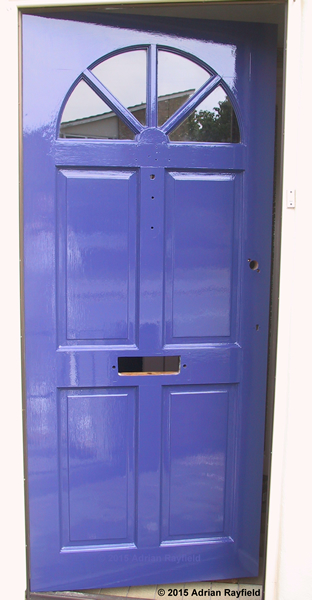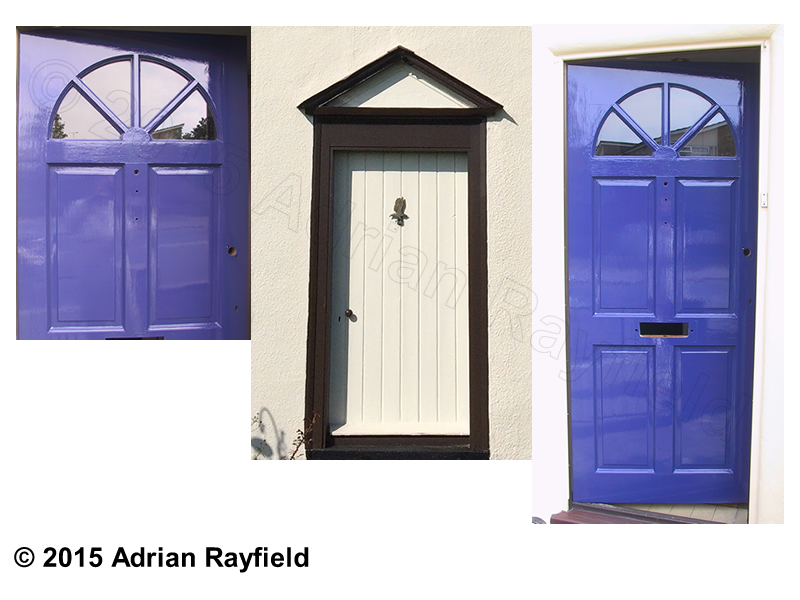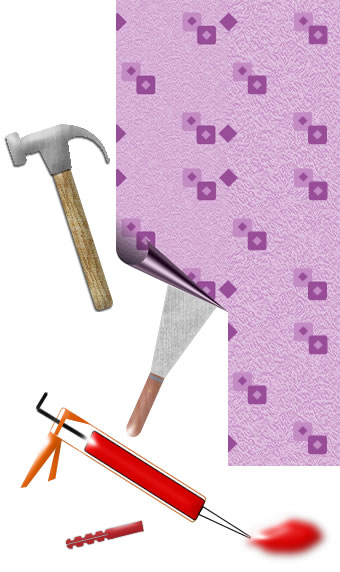Painting, decorating and home improvement tips blog
How to paint a front door
Posted by Adrian
May 18th, 2015

How to paint a front door
From time to time you will need to paint your front door, if it is wood that is. Ideally pick a couple of dry days to complete the job such as spring or summer. Pick a good quality exterior paint to ensure a long lasting job.
The front door is one of the most seen parts of your house, a good looking door gives a good impression to visitors, and especially if you are selling your house as it gives kerb appeal.
You should gather all the tools required before starting, you will need:
- Screwdrivers
- Adjustable spanner
- Sandpaper (various grades)
- Primer
- Undercoat
- Topcoat (Satin or gloss)
- Paint stripper (optional)
- Heat gun (optional)
- Scraper (optional)
Ironwork / Door furniture
The first job is to remove all ironwork or door furniture such as locks, knocker, letterbox, escutcheon, door pull and numbers. This will make it far easier for working on the door. Put everything to one side being careful not to lose any screws as some can be tiny and you will need them again later to refit the ironwork / door furniture. You may need an adjustable spanner for the knocker or letterbox.
Preparation
As with all decorating jobs, preparation is key and will take most of your time. Now is the time to decide if you are simply going to re-decorate your door, or give it a real overhaul and strip the existing finish off back to bare wood.
If you are going to remove all the existing paint finish you can do this either by using a heat gun and scraper, or paint remover and scraper. The choice is really up to you. Once the door is stripped give it a good rub down and fill any crack and holes and sand these level and smooth. Once you have done this you are now ready to move to the next section, prime.
If you decide against stripping the door back to bare wood, or it simply doesn’t need it you should give the existing surface a good clean off to remove dirt and grime with a cloth and maybe water, the give the surface a good rub down. Fill any cracks or unwanted holes and rub them down level and smooth. Dust off and you can move onto the next section, prime.
Prime
Once you have prepared the door you should prime the entire door if you have stripped it back to bare wood, or spot prime bare wood if you have just rubbed down and filled. Allow to dry before moving onto undercoating.
Undercoat
Once you have primed the door, whether it be the entire door or spot primed, give the primer a light sand down before applying one or two coats of undercoat. Allow each coat to dry fully if you give it more than one coat sand back between coats for that perfect smooth finish.
Topcoat
Once you have prepared the door correctly and given it it’s necessary coats of primer and undercoat you can now give the door it’s final sand back and the final coat, the topcoat. This maybe a satin finish or a gloss. Again you may want to give two topcoats, but read the manufacturer’s instructions to ensure you leave enough time between coats, and a word of warning, if you sandback, you a fine paper and use light strokes. If you are too harsh you could scratch the surface too much, or even worse roll up the first coat and ruin all your hard work.
Non-painted or varnished doors
This post deals with painted doors, such a glossed doors but for other finishes, such as varnish or stained door the principle is the same, apart from you wouldn’t use primer or undercoat, however the preparation part is still applicable and needs to be done.

Tags: Door, Door Furniture, Filler, Filling, Gloss, Ironwork, Knocker, Letterbox, Lock, Paint, Painting, Preparation, Primer, Satin, Topcoat, Undercoat, Varnish, Woodstain
Posted in Decorating Tips | 1 Comment »
Decorating and preparation
Posted by Adrian
February 9th, 2010

Decoration or Preparation?
Preparation is key
A good decorating job consists of 90% preparation and 10% decoration, get these percentages around the wrong way, and you’ll know about it.
Taking the time to prepare before you decorate will pay dividends by giving you a far superior finish.
Things such as removing old wallpaper, washing things down, dusting off all take time but need to be done and done right.
For ceiling and walls
Remove any old wallpaper first. Stick back any loose paper if you just want to paint over it.
Make sure any loose plaster is rectified; fill holes and cracks.
Remove any old rawl plugs and fill the holes.
Ensure filler is sanded down properly and not left high, as it will show.
Woodwork
Make sure you rub down woodwork before painting it.
Use a suitable primer on any bare wood, then undercoat it and then topcoat it.
If you topcoat straight over topcoat and not give the surface a key first the topcoat applied will easily chip or scratch off.
General
Let new plaster completely dry out before decorating.
Deal with any damp problems at source rather than just cover it up.
Remove any mould that may of grown and treat the affected area.
Remember, preparation is key. Do it well and it will show in the finished job, do it badly and you will see it forever!
Get a professional in if you are unsure what to do or simply don’t want to take the time to “prep for you dec”.
Tags: Ceiling, Decorating, Decoration, New Plaster, Preparation, Walls, Woodwork
Posted in Decorating Tips | 1 Comment »
